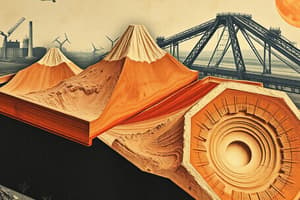Podcast
Questions and Answers
The cryosphere is the frozen water part of the Earth system. There are places on Earth that are so cold that water is frozen solid. The term “cryosphere” comes from the Greek word, “krios,” which means ________.
The cryosphere is the frozen water part of the Earth system. There are places on Earth that are so cold that water is frozen solid. The term “cryosphere” comes from the Greek word, “krios,” which means ________.
cold
The Earth is a sphere with a radius of about 6378 km. It has the following composition: Crust, Mantle, and ________.
The Earth is a sphere with a radius of about 6378 km. It has the following composition: Crust, Mantle, and ________.
Core
The crust is the most heterogeneous layer in the Earth. The crust is on average 33 km thick for continents and 10 km thick beneath oceans; however it varies from just a few km to over 70 km globally. The boundary between the crust and the mantle is mostly ________.
The crust is the most heterogeneous layer in the Earth. The crust is on average 33 km thick for continents and 10 km thick beneath oceans; however it varies from just a few km to over 70 km globally. The boundary between the crust and the mantle is mostly ________.
chemical
This boundary is referred to as the Mohorovičić discontinuity or “Moho”. It was discovered in 1910 by the Croatian seismologist ________ Mohorovičić.
This boundary is referred to as the Mohorovičić discontinuity or “Moho”. It was discovered in 1910 by the Croatian seismologist ________ Mohorovičić.
The Earth's crust is on average 33 km thick for continents and 10 km thick beneath oceans; however it varies from just a few km to over 70 km globally. The boundary between the crust and the mantle is mostly ________.
The Earth's crust is on average 33 km thick for continents and 10 km thick beneath oceans; however it varies from just a few km to over 70 km globally. The boundary between the crust and the mantle is mostly ________.
The crust and mantle have different compositions. This boundary is referred to as the Mohorovičić discontinuity or “Moho”. It was discovered in 1910 by the Croatian seismologist ________ Mohorovičić.
The crust and mantle have different compositions. This boundary is referred to as the Mohorovičić discontinuity or “Moho”. It was discovered in 1910 by the Croatian seismologist ________ Mohorovičić.
The crust is the most heterogeneous layer in the Earth. The crust is on average 33 km thick for continents and 10 km thick beneath oceans; however it varies from just a few km to over 70 km globally. The boundary between the crust and the mantle is referred to as the ________ discontinuity or “Moho”.
The crust is the most heterogeneous layer in the Earth. The crust is on average 33 km thick for continents and 10 km thick beneath oceans; however it varies from just a few km to over 70 km globally. The boundary between the crust and the mantle is referred to as the ________ discontinuity or “Moho”.
The cryosphere is the frozen water part of the Earth system. There are places on Earth that are so cold that water is frozen solid. The term “cryosphere” comes from the Greek word, “krios,” which means ________.
The cryosphere is the frozen water part of the Earth system. There are places on Earth that are so cold that water is frozen solid. The term “cryosphere” comes from the Greek word, “krios,” which means ________.
The Earth is a sphere with a radius of about 6378 km. It has the following composition: Crust, Mantle, and ________.
The Earth is a sphere with a radius of about 6378 km. It has the following composition: Crust, Mantle, and ________.
The crust is the most heterogeneous layer in the Earth. The crust is on average 33 km thick for continents and 10 km thick beneath oceans; however it varies from just a few km to over 70 km globally. The boundary between the crust and the mantle is mostly ________.
The crust is the most heterogeneous layer in the Earth. The crust is on average 33 km thick for continents and 10 km thick beneath oceans; however it varies from just a few km to over 70 km globally. The boundary between the crust and the mantle is mostly ________.
Flashcards are hidden until you start studying




